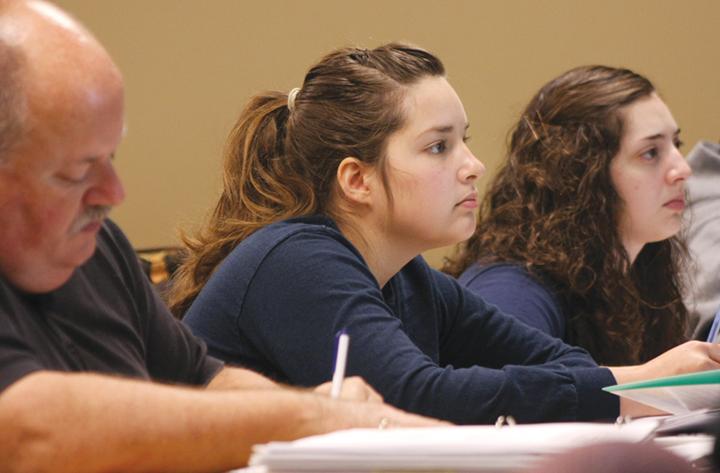Nursing courses divide for retention
Andrea Kew, senior nursing major, listens to lecture during the seven credit hour adult nursing class in the Health Sciences building Wednesday afternoon. This nursing class is one of two high credit hour classes that will divide into two courses to increase the number of program graduates.
The nursing program will be seeing some changes to two of its upper division classes in the fall semester of 2012 and spring semester of 2013.
Nursing 320 and Nursing 350 will be split into what BSN Coordinator and Associate Professor Grace Ayton calls “smaller chunks” to help improve retention rates and success of the students. The classes will be split up in two sections to give the students a better chance to maintain the required 2.5 grade-point average.
Currently, nursing students must pass both classes with a C or higher; the split will give the students a chance to be more aware or their risk of being dropped from the program and the opportunity to prevent that.
The material covered will not change in either class, but the split will help students who may be struggling.
If students earn a C in a four or five hour class, it will not drop their GPA as much as it would if they got the same grade in a seven or nine hour class.
“What used to be one nine hour class will now be two separate classes, one four, and one five hour class,” Dr. Mary Beth Linder, director of nursing, said.
They hope that by splitting the content in two sections it will give students the tools to be more successful. Giving students those tools to succeed and the ability to successfully complete the program is the main goal of the change.
“We want them to get through the program,” Ayton said.
“Anything we do is for the success of the students.”
The curriculum committee and faculty council, which is composed of 10 faculty members, has had to approve the changes and is confident that this is the right direction to take.
The decision had to be approved by a group majority of the faculty council.
The professors have experience and expertise in the areas they are teaching and explored all areas leading up to this change.
Ayton said the program has a completion rate that is higher than the national and state averages, and the faculty is always evaluating the curriculum with the purpose to better prepare students for the state boards. The nursing program is an accredited program and expected a visit this past week to renew their accreditation.
“We discussed it and decided it was a good time,” Ayton said.
The two classes being split are the clinical courses required for juniors and seniors in the program, which means that the changes will not affect current juniors and seniors enrolled in the program, since the changes won’t go into effect until the fall semester of 2012.
The new class schedule will be in the revised catalogue that current freshmen and sophomores will use in the upcoming fall semester.
The hope with the upcoming changes is to improve retention rates and success in those courses.
“This wasn’t something done lightly,” Ayton said. “We had faculty input. Everyone had a hand.”
Your donation will support the student journalists of Missouri Southern State University. Your contribution will allow us to purchase equipment and cover our annual website hosting costs.




























